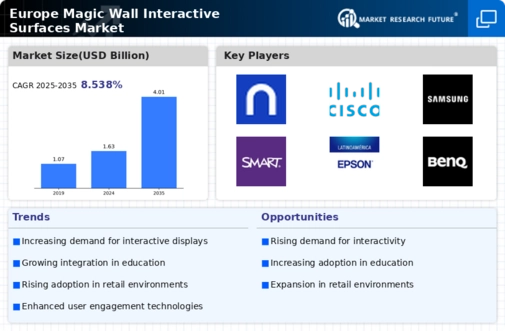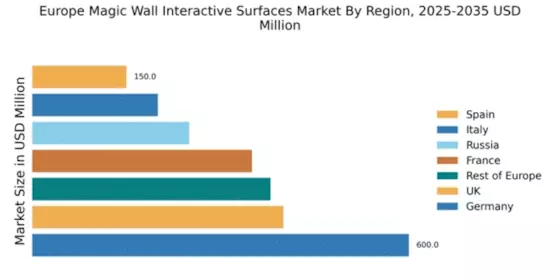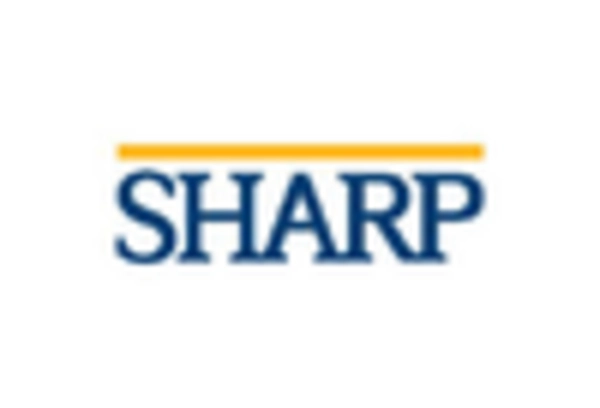Advancements in Display Technologies
Technological advancements in display technologies are significantly influencing the magic wall-interactive-surfaces market in Europe. Innovations such as OLED and microLED displays are enhancing the visual quality and interactivity of surfaces, making them more appealing to consumers and businesses alike. These advancements allow for higher resolution, better color accuracy, and improved energy efficiency, which are crucial for applications in advertising, education, and corporate environments. The market is expected to witness a shift towards these advanced display technologies, with projections indicating that by 2027, over 40% of interactive surfaces will utilize OLED technology. This shift not only enhances user experience but also aligns with the growing demand for sustainable and energy-efficient solutions in the industry.
Growing Emphasis on User-Centric Design
The magic wall-interactive-surfaces market in Europe is increasingly influenced by a growing emphasis on user-centric design principles. Companies are recognizing the importance of creating intuitive and accessible interfaces that cater to diverse user needs. This shift is particularly evident in sectors such as education and healthcare, where interactive surfaces are being designed to facilitate learning and improve patient engagement. Research indicates that user-centric designs can enhance user satisfaction by up to 30%, leading to higher adoption rates. As organizations prioritize user experience, the market is likely to see a rise in demand for customizable and adaptable interactive surfaces that can be tailored to specific user requirements.
Rising Demand for Interactive Experiences
The magic wall-interactive-surfaces market in Europe is experiencing a notable surge in demand for interactive experiences across various sectors, including retail, education, and entertainment. As consumers increasingly seek engaging and immersive environments, businesses are investing in innovative technologies that enhance user interaction. According to recent estimates, the market is projected to grow at a CAGR of approximately 15% over the next five years. This growth is driven by the need for businesses to differentiate themselves in a competitive landscape, leading to a greater adoption of interactive surfaces that facilitate dynamic content display and user engagement. The integration of augmented reality (AR) and virtual reality (VR) technologies further amplifies this trend, making interactive surfaces a vital component in creating memorable customer experiences.
Expansion of E-Commerce and Digital Retail
The expansion of e-commerce and digital retail is significantly impacting the magic wall-interactive-surfaces market in Europe. As online shopping continues to grow, retailers are seeking innovative ways to bridge the gap between physical and digital experiences. Interactive surfaces are being utilized in stores to create engaging displays that attract customers and enhance the shopping experience. This trend is supported by data indicating that retailers who implement interactive technologies can increase in-store sales by up to 20%. As the retail landscape evolves, the demand for interactive surfaces is expected to rise, with projections suggesting that the market could reach €500 million by 2028, driven by the need for enhanced customer engagement and personalized shopping experiences.
Increased Investment in Smart Infrastructure
The magic wall-interactive-surfaces market in Europe is benefiting from increased investment in smart infrastructure initiatives. Governments and private entities are recognizing the potential of interactive surfaces in enhancing urban environments, public spaces, and transportation systems. This trend is reflected in various smart city projects across Europe, where interactive surfaces are being integrated into public transport hubs, museums, and parks to provide real-time information and interactive experiences. As cities aim to improve citizen engagement and streamline services, the market is projected to grow, with investments expected to reach €1 billion by 2026. This focus on smart infrastructure not only promotes technological advancement but also fosters community interaction and participation.


















Leave a Comment